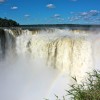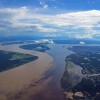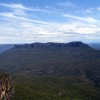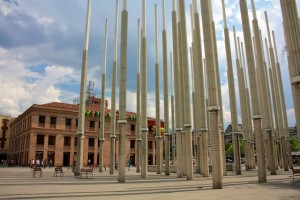How to Use a Polarizer Filter
| by Michael H. | 17 Comments » | Guest Post, Travel Gear
I am leery of writing a photography guest post on Two Backpackers, only because their photography is so amazingly good, but when Jason asked me to do a guest post, I was in the midst of posting one of my lucky-good photographs on my blog, so I thought I’d take a few paragraphs to explain how and why this particular shot turned out.
Patagonia Lighthouse
The Patagonia Lighthouse photo was one that I took fairly on during my RTW trip. The best photography tip I can give people in these days of digital photos is that you just need to take a few thousand photos and learn from the shots you take. Since there is no cost to taking photos anymore, just shoot like crazy with some different settings and techniques and learn from trial and error. That was far less possible back in the days when you had to pay to develop all your shots to look at them, but now there is no cost barrier.
In any case, this photograph was taken before I hit the 5,000 pictures mark on the trip. I was still in the baby phases of learning how to shoot photography. I was finally shooting in full manual mode and experimenting — in this case, I was experimenting with a circular polarizing filter.
Polarizer Filters

In these days of post-production manipulation via Photoshop, Aperture or Lightroom, some people might tell you that lens filters are unnecessary, and while that might be generally true, you do need a polarizer filter lens in my opinion.
Basically, a polarizing lens filter can darken the sky, turning it to a rich blue and reduce glare off objects and water. It is a really handy tool. In this particular photo of a boat in the Beagle Channel, I somehow managed to get the filter turned correctly which results in a deep, dark blue sky. In addition, the sun’s reflection off the water has been reduced, allowing the lighthouse reflection to shine through nicely.
I use a polarizing filter that screws into the end of my lens. When the filter lens is rotated the amount of effect changes.
Photography Tips
Polarizer Lens Tip 1
The filter is most effective if the sun is entering your picture at a 90 degree angle from left or right. It will have no effect at all if the sun in coming directly towards you or directly behind you. There are a variety of tips on how to judge this, but I find it simply this — keep the sun on my left or right shoulder — if the sun is 90 degrees to your camera lens, the filter will have its highest effect, lessening as the sun moves more towards to center (or immediate rear) of your shot.
Polarizer Lens Tip 2
Frame up your shot (with the sun hopefully on one of your shoulders or close to that angle), look through your viewfinder, and start rotating the polarizing filter lens around. You will have to rotate it to get the maximum effect — it isn’t just a “screw it on and shoot lens,” you need to fiddle with it a little. What you need to concentrate on is the sky. Rotate the lens all the way around a few times and when the sky is at its deepest blue, you have found the maximum effect. I almost always want the maximum effect, but you can adjust from there. Once you have done this a few dozen times, you will get the hang of it.
Polarizer Lens Tip 3
The lens does cut down reflection off objects and off water, so you might take shots where you aren’t focusing on the sky, but are shooting down nearer to the ground. If so, using the same direction you are going to shoot your tree or river shot, pan up to the sky and do the rotating looking at the sky until you find the sweet spot. Since you are shooting at the same angle to the sun, you can then reframe the shot down at what you are going to shoot and the lens will still be working to its maximum effect.
Polarizer Lens Tip 4
Since the filter is filtering out light, your camera is going to need to adjust with a longer shutter speed or bigger aperture. If you are shooting on any sort of automatic mode, your camera should do this automatically. If you are shooting on manual mode (which I highly encourage), you will need to make the adjustment, although it should be simple to see the exposure meter in your viewfinder to do so. The absorption is about 1.5-2 stops usually.
Polarizer Lens Tip 5
Shoot, shoot, shoot. When you start off, you can’t shoot too many photos. Experiment with sun position and the rotation of the polarizer lens. In the beginning, I thought there was some easy method for rotating the lens depending on the angle of the sun — there might be, but now I just go with the first two steps and shoot enough slightly different shots to compare later on my computer screen. Additionally, in the beginning, I’d shoot a couple shots of whatever you want to capture without the polarizing lens, just to make sure you don’t screw up all your shots and miss everything.
Joshua Tree National Park
Here is another example photograph that helps show the correct sun position relative to your shot. Joshua Tree was a shot that I took in that park near the end of the day. Notice the shadows cast by the tree and bushes — they are at a right angle to the direction that I am shooting. In other words, per tip #1, the sun is on my right shoulder.
I then rotated the lens around a bit until the sky took on that deep blue hue and clicked a few shots off. I hope you agree that the sky really sets off the tree and the hill quite well with that deep color. Its a little harder to notice in this shot, but you can also tell that you aren’t getting any annoying glare off anything either, mainly off the tree’s leaves, which you might have got without the filter.
Go Forth and Shoot
I hope you add this lens to your camera kit. It will cost you around $30-50 for one, but I think you’ll find it has so many uses that it is well worth the investment.






















I use a polarizing filter as well and I love it!! You made some great points though on how to use it- very useful.
thanks Laura. It took me a long time via trial and error (and tips from good photographers in person) to get competent with it. Still trying to learn more.
Except for nighttime photography, I pretty much live and die by my polarizer….it’s the single easiest way to produce photos that pop!
I agree Marsha. I use it almost all the time, unless there is a speed issue. It is really handy.
Great, Great, Great write up Mike!! Well said and laid out. A lot of people do think you don’t need filters anymore because so much can be photoshopped in but there are two filters that cant be reproduced in photoshop: Polarizer and Neutral Density. Anything after that you can technically recreate in post-processing but as any pro will tell you, doing it out of the camera is always best.
You should do more write ups like this man, was really good to read!
I gotta say, to get a complement on anything photography from you is a hell of a feather in my cap. Many thanks for the kind words!
Good stuff! I have polarizing filters, but often forget they are there, silly me. The 90 degree tip is a good one for a newbie like me. Thanks!
I’m not a big fan of the polarizer. It always produced dark edges on my photos when I used it, so I got rid of it and am happy without a filter. But these are good tips!
I should have mentioned this as one of the tips. Christy, did you use the pollarizer on top of the UV filter most of us use? If so, you will almost always get some funky going on in the 4 corners of the shot. You need to take the UV filter off and just use the polarizer.
I just bought my first polarization filter and am using it on my current 6-month trip through Peru. I think I’ve taken some pretty decent photos lately, but I really don’t see much (if any difference) between the photos with the polarization filter on and the photos with the filter off.
When I was looking at getting a filter, there were so many different kinds. Some where lighter than others. Some were name brand and others were not. Is there a particular type of filter that you recommend? And how can I tell if the filter is actually doing anything? I can’t really see much of a difference.
Great tips Michael! I recently just purchased this filter and you explained a few things for me. Cheers. ND filter is next on my list of things to get.
Great tips Michael! A polarizing filter can be a great tip and you did an excellent job explaining it!
Another great use for it is to shoot through a window and minimize reflections. I used to use mine all the time – i have weaned myself off it a bit lately but for beautiful deep skies and white clouds you can’t beat it. Likewise if you are going to shoot B&W you have to get yourself a red 25a filter for the same effect on skies, clouds, water, etc.
@Christine – the reason you are getting the edges is because your polarizer is too thick. I have a few of them and the one I love is the one that is thicker (sounds like yours) – the problem is it does leave the dark vignetting. I either work with it or crop it out. To use one and keep your skylight filter on you need to buy a very slim pro one so the edges don’t get in the way. But they can run big $$ depending on the mm of your lens. Also they are harder to spin just right because they are so much slimmer.
ahhhhh, shooting through a window. Cool. Need to try that. Have you shot down into water, so you can see underwater without the reflections?
A good et of tips here. The filter I love is my 9 stop ND filter. Slow down time and soften the water and add depth and interest to the clouds.
The most important thing about photography is getting out there shooting! The more you shoot the better your luck will get.
Very interesting post, this guy I met gave me one and I didn’t quite understand the purpose except getting rid of the reflection in window displays haha.
Awesome tips, a polarized filter really helps take photos to the next level.
I was just saying to Dalene last night how we need to get ourselves a polarized lens filter. Awesome article, this article and comments will help my argument significantly. Cheers!